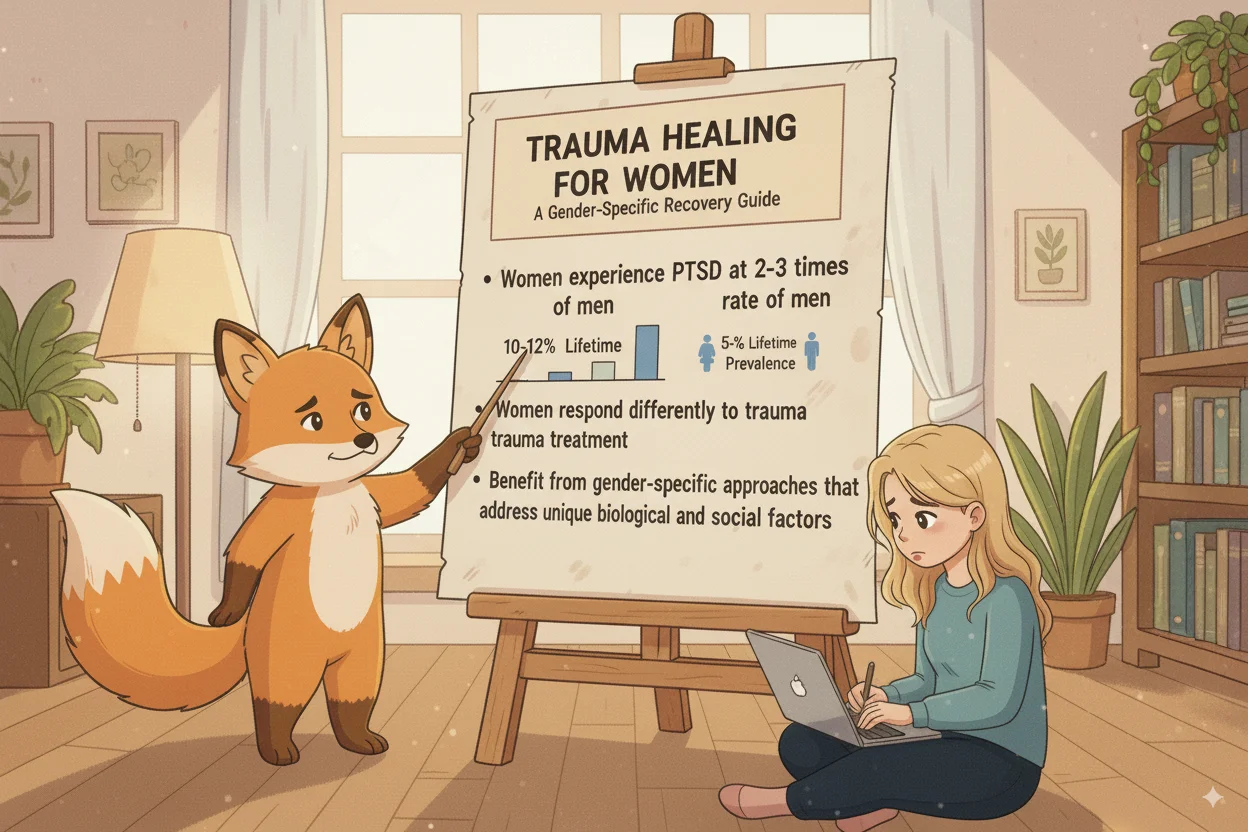
Trauma Healing for Women: A Gender-Specific Recovery Guide
Women experience PTSD at 2-3 times the rate of men and benefit from gender-specific approaches that address unique biological and social factors. Learn effective trauma recovery strategies designed for women.
Trauma Healing for Women: A Gender-Specific Recovery Guide
Why Women Need Different Trauma Treatment Approaches
Women experience PTSD at 2-3 times the rate of men, with 10-12% lifetime prevalence compared to 5-6% in men. Research reveals women respond differently to trauma treatment and benefit from gender-specific approaches that address unique biological and social factors.
Understanding Women's Trauma Response
Biological Differences in Trauma Processing
Hormonal influences:
- Estrogen affects memory consolidation during trauma
- Menstrual cycle phase impacts trauma symptom severity
- Pregnancy and postpartum create vulnerability periods
- Menopause reduces natural stress buffering
Brain structure differences:
- Women show greater amygdala activation during trauma recall
- Hippocampus (memory center) more affected by chronic stress
- Prefrontal cortex connectivity differs, affecting emotional regulation
Social and Cultural Factors
Women are more likely to experience:
- Childhood sexual abuse (1 in 4 vs 1 in 6 men)
- Intimate partner violence (1 in 4 lifetime prevalence)
- Complex trauma from repeated victimization
- Secondary trauma from caregiving roles
Types of Trauma Affecting Women Disproportionately
Sexual Trauma
Statistics: 81% of women experience sexual harassment or assault Unique impacts: Body image issues, sexual dysfunction, hypervigilance in relationships Recovery focus: Reclaiming bodily autonomy, rebuilding trust
Intimate Partner Violence
Recognition signs: Physical, emotional, sexual, financial, or digital abuse Complex dynamics: Trauma bonding, learned helplessness, economic dependence Recovery challenges: Safety planning, rebuilding identity, breaking isolation
Birth Trauma
Prevalence: 30% of women report traumatic birth experiences Symptoms: PTSD symptoms related to delivery, fear of future pregnancies Treatment needs: Processing medical trauma, addressing anxiety about motherhood
Intergenerational Trauma
Definition: Trauma passed down through families and cultures Impact: Higher rates of anxiety, depression, and PTSD in daughters Healing: Understanding family patterns, breaking cycles
Evidence-Based Treatment Approaches for Women
Trauma-Focused CBT (TF-CBT)
Why it works for women:
- Addresses cognitive patterns specific to female socialization
- Incorporates safety planning essential for ongoing threats
- Focuses on self-blame reduction common in women
Treatment components:
- Trauma narrative processing
- Cognitive restructuring of shame and guilt
- Exposure therapy for avoidance behaviors
- Relapse prevention planning
Research outcomes: 70% of women show significant PTSD reduction in 12-16 sessions
EMDR for Women's Trauma
Advantages:
- Doesn't require detailed verbal processing (helpful for shame)
- Addresses body-based trauma memories
- Effective for complex trauma histories
Gender-specific adaptations:
- Resource building phase longer for women with complex trauma
- Body awareness integration for sexual trauma survivors
- Future templating for safety and empowerment
Success rates: 90% of women with single-incident trauma recover in 3-6 sessions
Somatic Approaches
Why women benefit:
- Women often store trauma in the body
- Addresses disconnection from physical self
- Rebuilds sense of safety in the body
Techniques include:
- Body awareness exercises
- Breathing and movement
- Boundary setting practices
- Grounding through physical sensation
Group Therapy Benefits for Women
Research shows women benefit more from group support:
- Reduces shame and isolation
- Provides modeling of healthy relationships
- Addresses common patterns (people-pleasing, self-sacrifice)
- Creates sisterhood and mutual support
Effective group formats:
- Trauma recovery groups
- DBT skills groups
- Art or expressive therapy groups
- Support groups for specific traumas
The Role of Relationships in Women's Trauma Recovery
Attachment and Trauma
Women's sense of self often develops through relationships. Trauma disrupts this, creating:
- Fear of abandonment
- Difficulty trusting
- People-pleasing behaviors
- Loss of personal boundaries
Healing Through Connection
Safe relationships promote recovery:
- Therapeutic relationship as corrective experience
- Supportive friendships reduce PTSD symptoms by 40%
- Healthy romantic relationships aid long-term recovery
- Mother-daughter healing impacts intergenerational trauma
Addressing Women-Specific Trauma Symptoms
Body Image and Sexuality
Common issues:
- Disconnection from physical self
- Sexual dysfunction or avoidance
- Eating disorders as trauma response
- Self-harm behaviors
Treatment approaches:
- Body-positive therapy
- Sexual trauma-informed counseling
- Mindful movement and yoga
- Art therapy for body image
Motherhood and Trauma
Unique challenges:
- Hypervigilance about children's safety
- Difficulty with physical intimacy during pregnancy/nursing
- Birth trauma affecting bonding
- Intergenerational trauma concerns
Support strategies:
- Trauma-informed prenatal care
- Postpartum PTSD treatment
- Mother-infant therapy
- Parenting support groups
Cultural Considerations in Women's Trauma Treatment
Addressing Cultural Stigma
Different cultures view trauma and mental health differently:
- Some cultures discourage discussing personal problems
- Religious beliefs may conflict with treatment approaches
- Family loyalty may prevent disclosure of family trauma
- Economic dependence may limit treatment options
Culturally Responsive Treatment
Effective approaches include:
- Bilingual therapists when needed
- Understanding cultural context of trauma
- Incorporating cultural strengths and resources
- Addressing immigration trauma and discrimination
Creating Your Women-Focused Trauma Recovery Plan
Phase 1: Safety and Stabilization (Months 1-3)
Goals:
- Establish physical and emotional safety
- Learn coping skills for trauma symptoms
- Build therapeutic relationship
- Address immediate crisis situations
Key activities:
- Safety planning if ongoing threats exist
- Grounding and self-soothing techniques
- Basic emotion regulation skills
- Building support network
Phase 2: Trauma Processing (Months 3-12)
Goals:
- Process traumatic memories safely
- Reduce PTSD symptoms
- Address trauma-related beliefs
- Rebuild sense of self
Treatment options:
- EMDR or trauma-focused CBT
- Narrative therapy approaches
- Somatic experiencing
- Expressive arts therapy
Phase 3: Integration and Growth (Months 6-18)
Goals:
- Integrate healing into daily life
- Rebuild relationships and intimacy
- Develop future goals and dreams
- Prevent relapse
Focus areas:
- Relationship skills training
- Career or education planning
- Parenting support if applicable
- Spiritual or meaning-making work
Self-Care Strategies During Trauma Recovery
Daily Practices
Morning routine:
- 5 minutes of gentle stretching or movement
- Positive affirmations focused on safety and strength
- Nutritious breakfast to stabilize mood
Throughout the day:
- Regular check-ins with body sensations
- Boundary-setting practice
- Connection with at least one supportive person
Evening routine:
- Journaling or creative expression
- Relaxation techniques
- Preparing safe sleep environment
Weekly Practices
- Engage in one enjoyable activity for yourself
- Spend time in nature
- Practice saying "no" to overwhelming requests
- Connect with trauma recovery community
Red Flags: When to Seek Immediate Help
- Suicidal thoughts or self-harm impulses
- Substance abuse as primary coping mechanism
- Inability to care for children or fulfill basic responsibilities
- Flashbacks or dissociation that interfere with daily life
- Isolation lasting more than two weeks
Building Resilience: Long-Term Recovery Strategies
Developing Personal Strengths
Research identifies key resilience factors for women:
- Strong sense of personal identity
- Ability to form and maintain relationships
- Meaning-making and spiritual beliefs
- Problem-solving skills and flexibility
- Self-compassion and self-care practices
Creating Post-Traumatic Growth
Many women report positive changes after trauma recovery:
- Increased empathy and compassion
- Stronger relationships and boundaries
- Clarified values and priorities
- Spiritual growth and meaning
- Advocacy for other survivors
Resources and Support
Crisis Resources
- National Sexual Assault Hotline: 1-800-656-HOPE
- National Domestic Violence Hotline: 1-800-799-SAFE
- Crisis Text Line: Text HOME to 741741
Finding Trauma-Informed Therapists
- Psychology Today therapist finder
- EMDR International Association directory
- Local rape crisis centers for referrals
- Women's centers and domestic violence organizations
Remember: healing from trauma is not about returning to who you were before - it's about becoming who you were meant to be. With proper support and evidence-based treatment, recovery is not only possible but can lead to profound growth and empowerment.
Did this article help you on your healing journey? I'd love to hear from you!
Send Sisi a Message